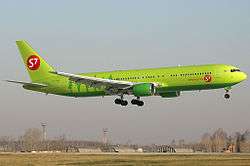Air travel


Air travel is a form of travel in vehicles such as helicopters, hot air balloons, blimps, gliders, hang gliding, parachuting, airplanes, jets, or anything else that can sustain flight.[1] Use of air travel has greatly increased in recent decades - worldwide it doubled between the mid-1980s and the year 2000.[2]
Domestic and international flights
Air travel can be separated into two general classifications: national/domestic and international flights. Flights from one point to another within the same country are called domestic flights. Flights from a point in one country to a point within a different country are known as international flights. Travelers can use domestic or international fights in either private or public travel.
Air travel
Travel class on an airplane is usually split into a two, three or four class model service. US Domestic flights usually have two classes: Economy Class and a Domestic First Class partitioned into cabins. International flights may have up to four classes: Economy Class; Premium Economy; Business Class or Club Class; and First Class.
Most air travel starts and ends at a commercial airport. The typical procedure is check-in; border control; airport security baggage and passenger check before entering the gate; boarding; flying; and pick-up of luggage and - limited to international flights - another border control at the host country's border.
Health effects
Deep vein thrombosis (DVT) is the third most common vascular disease next to stroke and heart attack. It is estimated that DVT affects one in 5,000 travellers on long flights.[3][4] Risk increases with exposure to more flights within a short time frame and with increasing duration of flights.[4]
During flight, the aircraft cabin pressure is usually maintained at the equivalent of 6,000–8,000 ft (1,829–2,438 m) above sea level. Most healthy travelers will not notice any effects. However, for travelers with cardiopulmonary diseases (especially those who normally require supplemental oxygen), cerebrovascular disease, anemia, or sickle cell disease, conditions in an aircraft can exacerbate underlying medical conditions. Aircraft cabin air is typically dry, usually 10%–20% humidity, which can cause dryness of the mucous membranes of the eyes and airways.[5]
See also
References
- ↑ "Aviation." Encyclopædia Britannica. Accessed June 2011.
- ↑ http://www.worldwatch.org/system/files/EWP159.pdf
- ↑ Marchitelli, Rosa (30 May 2016). "Air Canada passenger suffers 'horrible pain' after being stuck in cramped seat". CBC. Retrieved 30 May 2016.
- 1 2 The absolute risk of venous thrombosis after air travel
- ↑ http://wwwnc.cdc.gov/travel/yellowbook/2014/chapter-6-conveyance-and-transportation-issues/air-travel
External links
| Wikimedia Commons has media related to Air transport. |
- Chasing the Sun - History of commercial aviation, from PBS